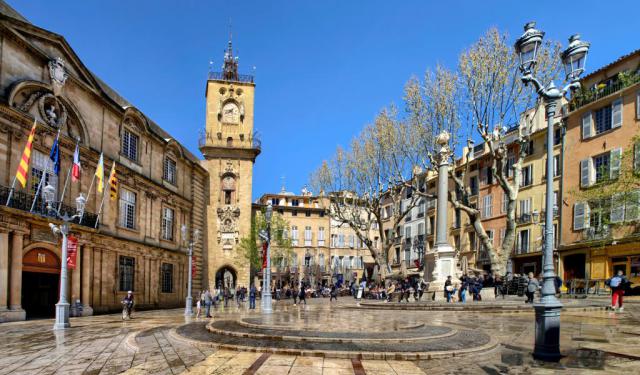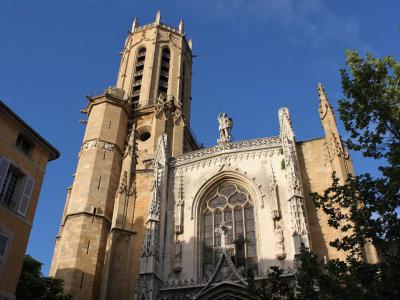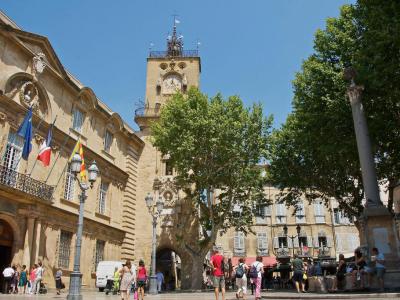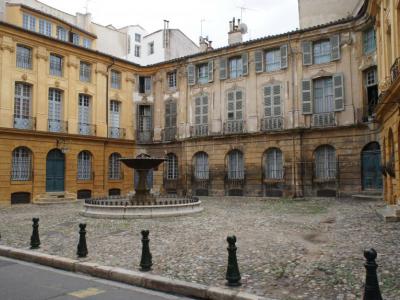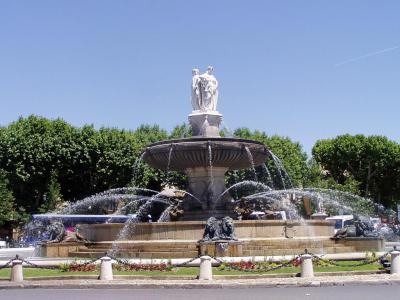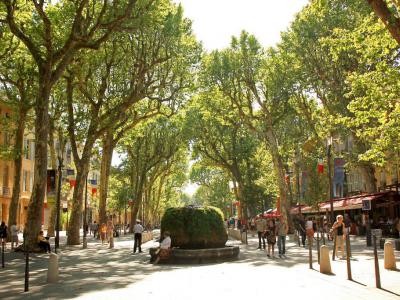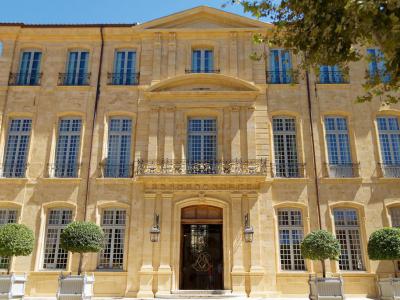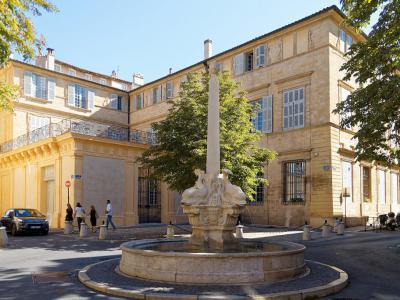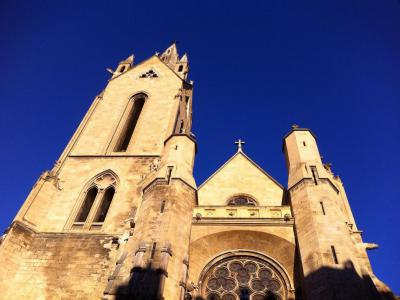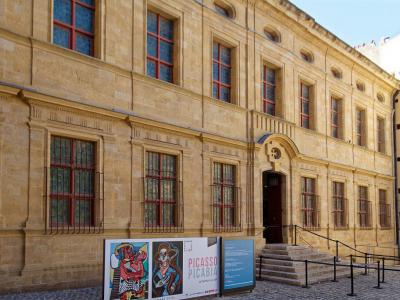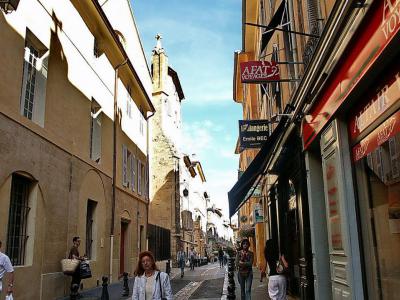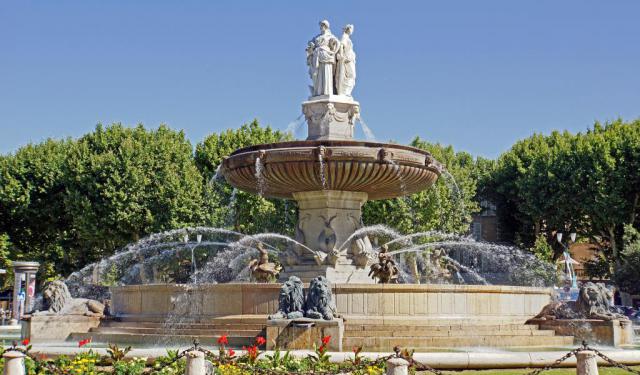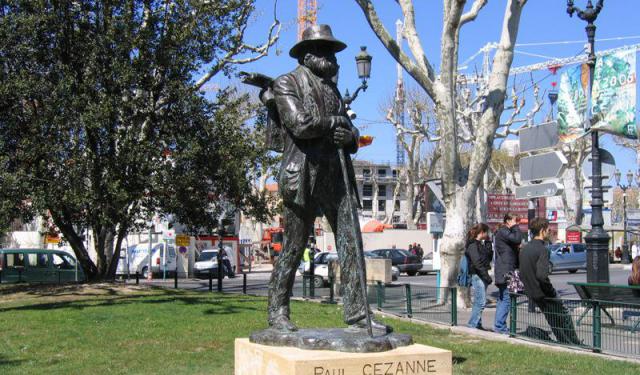Audio Guide: Aix-en-Provence Introduction Walking Tour (Self Guided), Aix-en-Provence
Aix-en-Provence may not have coastal views, but it compensates in style with its Roman bathwater and city logistics. Founded in 123 BC by Roman consul Gaius Sextius Calvinus, this southern French settlement-originally named Aquae Sextiae, which means “Waters of Sextius”-was built around its thermal springs and the promise of a good soak. Centuries later, the name was streamlined to “Aix”, the Romans were out, but the waters remained, and Aix was on its way to becoming the cultural capital of Provence.
By the Middle Ages, Aix had swapped statues for scholars and took center stage under the Houses of Aragon and Anjou. It became a court city, an administrative hub, and a magnet for artists and legal minds. In 1487, the city officially joined France, and the following centuries brought layers of architectural ambition: Gothic churches, Baroque fountains, and 17th-century boulevards, all woven through the narrow medieval lanes of the old town. Aix Cathedral-built on the site of the former Roman temple-reflects that long history in one eclectic structure of Romanesque arches, Gothic vaults, and a Baroque façade that stops short of picking a favorite style.
Step into modern Aix and you'll still see the past elbowing its way in. The Fountain of the Rotunda, a 19th-century centerpiece with its trio of allegorical figures, lions, and dolphins, anchors one end of Mirabeau Boulevard. The other end leads you toward the statue of Paul Cézanne, Aix’s most famous son. His life and legacy ripple through the city, especially along the self-guided Paul Cézanne walk, which links his childhood home, studios, and favorite painting spots. The Granet Museum adds context, housing works by Cézanne, Ingres, and others in a former priory just a short walk from the Mazarin District.
The Mazarin District, laid out in the 17th century by Cardinal Mazarin’s team, is a refined grid of mansions and quiet lanes, home to the much-photographed Fountain of the Four Dolphins. Nearby, the Church of Saint John-the oldest Gothic church in Provence-stands opposite the Granet. North of Mirabeau, the old town offers the 17th-century clock tower on Town Hall Square, the harmonious façades of Albertas Square, and Italy Street, once part of the Roman road system.
Aix’s cultural life is just as layered. The Festival of Lyric Art brings opera to the Grand Theater of Provence each summer, while Music in the Street turns plazas and alleys into stages every June.
You won’t find the sea here, but Aix doesn’t chase that kind of approval. Its fountains speak for its Roman past, its buildings track five centuries of power and taste, and its cultural calendar keeps the rhythm going. Cézanne missed it when he was away. You probably will too.
By the Middle Ages, Aix had swapped statues for scholars and took center stage under the Houses of Aragon and Anjou. It became a court city, an administrative hub, and a magnet for artists and legal minds. In 1487, the city officially joined France, and the following centuries brought layers of architectural ambition: Gothic churches, Baroque fountains, and 17th-century boulevards, all woven through the narrow medieval lanes of the old town. Aix Cathedral-built on the site of the former Roman temple-reflects that long history in one eclectic structure of Romanesque arches, Gothic vaults, and a Baroque façade that stops short of picking a favorite style.
Step into modern Aix and you'll still see the past elbowing its way in. The Fountain of the Rotunda, a 19th-century centerpiece with its trio of allegorical figures, lions, and dolphins, anchors one end of Mirabeau Boulevard. The other end leads you toward the statue of Paul Cézanne, Aix’s most famous son. His life and legacy ripple through the city, especially along the self-guided Paul Cézanne walk, which links his childhood home, studios, and favorite painting spots. The Granet Museum adds context, housing works by Cézanne, Ingres, and others in a former priory just a short walk from the Mazarin District.
The Mazarin District, laid out in the 17th century by Cardinal Mazarin’s team, is a refined grid of mansions and quiet lanes, home to the much-photographed Fountain of the Four Dolphins. Nearby, the Church of Saint John-the oldest Gothic church in Provence-stands opposite the Granet. North of Mirabeau, the old town offers the 17th-century clock tower on Town Hall Square, the harmonious façades of Albertas Square, and Italy Street, once part of the Roman road system.
Aix’s cultural life is just as layered. The Festival of Lyric Art brings opera to the Grand Theater of Provence each summer, while Music in the Street turns plazas and alleys into stages every June.
You won’t find the sea here, but Aix doesn’t chase that kind of approval. Its fountains speak for its Roman past, its buildings track five centuries of power and taste, and its cultural calendar keeps the rhythm going. Cézanne missed it when he was away. You probably will too.
How it works: Download the app "GPSmyCity: Walks in 1K+ Cities" from Apple App Store or Google Play Store to your mobile phone or tablet. The app turns your mobile device into a personal tour guide and its built-in GPS navigation functions guide you from one tour stop to next. The app works offline, so no data plan is needed when traveling abroad.
Aix-en-Provence Introduction Walking Tour Map
Guide Name: Aix-en-Provence Introduction Walking Tour
Guide Location: France » Aix-en-Provence (See other walking tours in Aix-en-Provence)
Guide Type: Self-guided Walking Tour (Sightseeing)
# of Attractions: 10
Tour Duration: 1 Hour(s)
Travel Distance: 1.7 Km or 1.1 Miles
Author: DanaOffice
Sight(s) Featured in This Guide:
Guide Location: France » Aix-en-Provence (See other walking tours in Aix-en-Provence)
Guide Type: Self-guided Walking Tour (Sightseeing)
# of Attractions: 10
Tour Duration: 1 Hour(s)
Travel Distance: 1.7 Km or 1.1 Miles
Author: DanaOffice
Sight(s) Featured in This Guide:
- Cathedrale Saint-Sauveur d'Aix-en-Provence (Aix Cathedral)
- Place de l'Hôtel de Ville (Town Hall Square)
- Place et Fontaine d'Albertas (Albertas Square and Fountain)
- Fontaine de la Rotonde (Fountain of the Rotunda)
- Cours Mirabeau (Mirabeau Boulevard)
- Hotel de Caumont (Caumont Hotel)
- Mazarin District and Fountain of the Four Dolphins
- Eglise Saint-Jean-de-Malte (Church of Saint John)
- Musee Granet (Granet Museum)
- Rue d'Italie (Italy Street)
1) Cathedrale Saint-Sauveur d'Aix-en-Provence (Aix Cathedral) (must see)
Seventeenth-century writer Jean Pitton claimed that Aix Cathedral rose where a Roman temple to Apollo once stood-proof that even the gods can’t hold onto prime real estate forever. The site’s first church was reportedly founded around 500 AD by Saint Maximinus, who, according to tradition, arrived from Jerusalem with Mary Magdalene in a boat generously lent by Saint Lazarus. Apparently divine Uber was a thing back then.
The cathedral we see today took root in the 12th century with a solid Romanesque nave. Then came a second one in 1171, dedicated to Saint Maximinus himself, squeezing in between the original nave and baptistry like a holy architectural remix. The 14th century brought more flair, with a Gothic-style transept added in 1318-clearly, Aix was keeping up with cathedral trends.
Outside, the façade is a theatrical display of late Gothic drama: pointed arches, slim yellowish buttresses, and twelve Apostles playing hide-and-seek in the niches-three upfront, the rest loitering in the wings. Above it all, Archangel Michael takes center stage, dramatically skewering a dragon atop the balustrade. The walnut portal doors, carved in 1505, add a final flourish of detail, leading into a space that juggles three styles-Romanesque on one side, Gothic down the middle, and Baroque along the north.
Inside, it’s not just architecture on show. You’ll find the 5th-century baptistry with Roman columns still holding their ground, plus a high altar supported by bronze figures of the Holy Trinity. The walls display works by Nicolas Froment, Jean Daret, and Louis Finson-a follower of Caravaggio known for his dramatic flair. One standout treasure is a set of 16th-century tapestries, originally woven for Canterbury Cathedral and brought to Aix long before international art loans became the norm.
And then there’s Cézanne. The hometown icon, who once called Aix the best place to live, painted the cathedral repeatedly from a spot just a short walk from his studio.When he died in 1906, it was here-under the watch of archangels, apostles, and centuries of layered stone-that he took his final bow.
The cathedral we see today took root in the 12th century with a solid Romanesque nave. Then came a second one in 1171, dedicated to Saint Maximinus himself, squeezing in between the original nave and baptistry like a holy architectural remix. The 14th century brought more flair, with a Gothic-style transept added in 1318-clearly, Aix was keeping up with cathedral trends.
Outside, the façade is a theatrical display of late Gothic drama: pointed arches, slim yellowish buttresses, and twelve Apostles playing hide-and-seek in the niches-three upfront, the rest loitering in the wings. Above it all, Archangel Michael takes center stage, dramatically skewering a dragon atop the balustrade. The walnut portal doors, carved in 1505, add a final flourish of detail, leading into a space that juggles three styles-Romanesque on one side, Gothic down the middle, and Baroque along the north.
Inside, it’s not just architecture on show. You’ll find the 5th-century baptistry with Roman columns still holding their ground, plus a high altar supported by bronze figures of the Holy Trinity. The walls display works by Nicolas Froment, Jean Daret, and Louis Finson-a follower of Caravaggio known for his dramatic flair. One standout treasure is a set of 16th-century tapestries, originally woven for Canterbury Cathedral and brought to Aix long before international art loans became the norm.
And then there’s Cézanne. The hometown icon, who once called Aix the best place to live, painted the cathedral repeatedly from a spot just a short walk from his studio.When he died in 1906, it was here-under the watch of archangels, apostles, and centuries of layered stone-that he took his final bow.
2) Place de l'Hôtel de Ville (Town Hall Square) (must see)
Town Hall Square may sound like bureaucracy central, but in Aix-en-Provence, it’s where history and art come together in a picturesque standoff. This central square has been keeping civic life scenic since the 14th century-though the current Town Hall, finished in 1678, is the spruced-up version by architect Pierre Pavillon. Bonus trivia: Paul Cézanne, tied the knot here in 1886. Romance and paperwork-two Provence traditions.
Towering above the square is the Clock Tower, built in 1510 from white limestone and accessorized with an astronomical clock from 1661. It also sports a medieval bell once used to enforce feudal dues-a cheerful reminder that history is full of taxes in disguise. Think of it as a giant stone calendar that occasionally scolds peasants.
Right beside the Town Hall sits the former Corn Exchange Hall, an 18th-century building that clearly believed grain deserved glamour. Now repurposed as a library and post office, it continues to deliver-just with books and stamps. Sorry, no more corn. Anchoring the square is a glorious fountain by Jean Chastel, topped with a Roman column from 1755, adding a touch of imperial flair to your afternoon amble.
Today, the square balances old-world elegance with everyday charm. You’ll find café tables spilling into the cobbles, a flower market in full bloom on Tuesdays, Thursdays, and Saturdays, and a book fair on the first Sunday of every month. Bureaucracy has never looked this lovely.
Towering above the square is the Clock Tower, built in 1510 from white limestone and accessorized with an astronomical clock from 1661. It also sports a medieval bell once used to enforce feudal dues-a cheerful reminder that history is full of taxes in disguise. Think of it as a giant stone calendar that occasionally scolds peasants.
Right beside the Town Hall sits the former Corn Exchange Hall, an 18th-century building that clearly believed grain deserved glamour. Now repurposed as a library and post office, it continues to deliver-just with books and stamps. Sorry, no more corn. Anchoring the square is a glorious fountain by Jean Chastel, topped with a Roman column from 1755, adding a touch of imperial flair to your afternoon amble.
Today, the square balances old-world elegance with everyday charm. You’ll find café tables spilling into the cobbles, a flower market in full bloom on Tuesdays, Thursdays, and Saturdays, and a book fair on the first Sunday of every month. Bureaucracy has never looked this lovely.
3) Place et Fontaine d'Albertas (Albertas Square and Fountain)
Back in the 16th century, Jean Agar-an adviser to the Parliament of Aix-decided to part ways with his residence, handing it off. A few generations later, the house's square got sold to the d'Albertas clan, who had traded the hills of Alba, Italy, for Provence way back in the 14th century. Skipping forward to 1724, and Henri d'Albertas, royal adviser and apparent fan of urban upgrades, hired city architect Laurent Vallon to give his home a stylish overhaul. Not content with curb appeal alone, Henri bought the houses across the street and promptly flattened them for the greater architectural good.
Henri didn’t live to see the full glow-up, but his son Jean-Baptiste picked up where Dad left off, handing the project to Laurent’s son, Georges Vallon. Now that is a generational collaboration, literally. Georges, now city architect himself, drew inspiration from the grand squares of Paris and created a petite but polished plaza in front of the family residence. Today’s Albertas Square is framed by four nearly identical mansions, all with dignified facades and balconies that seem to ask, “Did someone order symmetry?”
At its center stands the Albertas Fountain-a cast-iron chalice calmly anchoring the square with just enough presence to turn heads without raising eyebrows. The decorative railing encircling the basin was forged by students from the local School of Arts and Crafts, their style merging seamlessly to the architect's.
Henri didn’t live to see the full glow-up, but his son Jean-Baptiste picked up where Dad left off, handing the project to Laurent’s son, Georges Vallon. Now that is a generational collaboration, literally. Georges, now city architect himself, drew inspiration from the grand squares of Paris and created a petite but polished plaza in front of the family residence. Today’s Albertas Square is framed by four nearly identical mansions, all with dignified facades and balconies that seem to ask, “Did someone order symmetry?”
At its center stands the Albertas Fountain-a cast-iron chalice calmly anchoring the square with just enough presence to turn heads without raising eyebrows. The decorative railing encircling the basin was forged by students from the local School of Arts and Crafts, their style merging seamlessly to the architect's.
4) Fontaine de la Rotonde (Fountain of the Rotunda)
The Count of Valbelle checked out in 1779, but not before leaving the city of Aix a generous parting gift: 30,000 livres, which was the currency at the time. By November, the city decided to put that money to work-out went the crumbling ramparts, and in came plans for something more civic-minded. Ideas floated around for a while (as they tend to do), but it wasn’t until 1860 that the most iconic splash zone in town got born: the Fountain of the Rotunda.
Long known for its love affair with water-from Roman baths to bubbling neighborhood spouts-Aix needed a proper fountain to fortify its reputation. The Rotunda Fountain delivered. Towering nearly 40 feet, it was the first in the city to feature a cast-iron basin. Lions lounge around its edge like they own the place, while bronze children cling to swans mid-ride, adding just the right touch of misdemeanor.
Further up, a second bowl rests above the pool, this one guarded by snarling cheetah heads that look like they’ve seen things. Crowning the whole affair is a trio of ladies-each facing a different destiny. “Justice,” by Joseph Marius Ramus, stares down Mirabeau Boulevard toward the courthouse. “Commerce and Agriculture,” by Louis Chabaud, keep watch toward Marseille’s factories. And “Fine Arts,” by Hippolyte Ferrat, gazes toward Avignon. Together, they’re known as the Three Graces-a rather dignified nickname for a fountain that never stops showing off.
Long known for its love affair with water-from Roman baths to bubbling neighborhood spouts-Aix needed a proper fountain to fortify its reputation. The Rotunda Fountain delivered. Towering nearly 40 feet, it was the first in the city to feature a cast-iron basin. Lions lounge around its edge like they own the place, while bronze children cling to swans mid-ride, adding just the right touch of misdemeanor.
Further up, a second bowl rests above the pool, this one guarded by snarling cheetah heads that look like they’ve seen things. Crowning the whole affair is a trio of ladies-each facing a different destiny. “Justice,” by Joseph Marius Ramus, stares down Mirabeau Boulevard toward the courthouse. “Commerce and Agriculture,” by Louis Chabaud, keep watch toward Marseille’s factories. And “Fine Arts,” by Hippolyte Ferrat, gazes toward Avignon. Together, they’re known as the Three Graces-a rather dignified nickname for a fountain that never stops showing off.
5) Cours Mirabeau (Mirabeau Boulevard) (must see)
Gabriel Riqueti, Count of Mirabeau, was a man of big gestures and even bigger contradictions. He spoke for liberty, flirted with monarchy, and somehow managed to represent Aix at the General Assembly in 1789 without burning any bridges-at least not immediately. When he died in 1791, France collectively put down its quills and mourned.
A few decades and revolutions later, Aix named its most iconic street after him: Mirabeau Boulevard. Back in 1649, however, this grand promenade was just a gleam in Archbishop Michel Mazarin’s eye. With the city bursting at the seams, Mazarin tore down the southern ramparts to build a tree-lined thoroughfare fit for gilded carriages, powdered wigs, and Sunday strolls. Architect Jean Lombard helped draft the blueprint for this upscale expansion, turning what was once a defense wall into something much more stylish.
It took fifteen years of rubble removal to make way for the noble set, but the result still impresses: a leafy tunnel of plane trees lined with elegant mansions, wrought-iron balconies, and enough cafés to caffeinate all of Provence. The name “Mirabeau” wasn’t slapped on until 1876, but the spirit of grandeur had been there from the beginning.
Fountains punctuate the boulevard like commas in a particularly well-watered sentence. There’s the showy Fountain of the Rotunda at one end, the Fountain of the Nine Canons mid-way, and the Mossy Fountain, which looks exactly like it sounds. As for the Fountain of the Seahorses, it vanished in 1777; today, only a stony lump remains to tell the tale.
A statue of King René marks the east end of the boulevard, looking pleased with the view-shopfronts now outnumber mansions, but the Boulevard still holds its swagger. Like its namesake, it doesn’t quite pick a side-bourgeois polish, revolutionary echoes, and a strong preference for table service.
A few decades and revolutions later, Aix named its most iconic street after him: Mirabeau Boulevard. Back in 1649, however, this grand promenade was just a gleam in Archbishop Michel Mazarin’s eye. With the city bursting at the seams, Mazarin tore down the southern ramparts to build a tree-lined thoroughfare fit for gilded carriages, powdered wigs, and Sunday strolls. Architect Jean Lombard helped draft the blueprint for this upscale expansion, turning what was once a defense wall into something much more stylish.
It took fifteen years of rubble removal to make way for the noble set, but the result still impresses: a leafy tunnel of plane trees lined with elegant mansions, wrought-iron balconies, and enough cafés to caffeinate all of Provence. The name “Mirabeau” wasn’t slapped on until 1876, but the spirit of grandeur had been there from the beginning.
Fountains punctuate the boulevard like commas in a particularly well-watered sentence. There’s the showy Fountain of the Rotunda at one end, the Fountain of the Nine Canons mid-way, and the Mossy Fountain, which looks exactly like it sounds. As for the Fountain of the Seahorses, it vanished in 1777; today, only a stony lump remains to tell the tale.
A statue of King René marks the east end of the boulevard, looking pleased with the view-shopfronts now outnumber mansions, but the Boulevard still holds its swagger. Like its namesake, it doesn’t quite pick a side-bourgeois polish, revolutionary echoes, and a strong preference for table service.
6) Hotel de Caumont (Caumont Hotel) (must see)
The Caumont Hotel may sound like a boutique stay with extra fluff pillows, but it's actually one of Aix’s finest 18th-century mansions-now operating as an art centre. Designed in 1715 by Robert de Cotte and Georges Vallon for the Marquess of Cabannes, the residence comes complete with an imposing entrance flanked by an Atlas sculpture courtesy of Rambot and Toro-yes, real sculptors, not a circus duo.
Over the centuries, the place rotated through various hands, eventually landing with the city of Aix in 1964. It moonlighted as a post office until 1970, and then hosted the Darius Milhaud Conservatory-proof that this house has always had good acoustics and a social calendar. The original owners of this Mazarin Quarter gem weren’t shy about entertaining either; they even had rooms dedicated just to music and mingling.
Inside, it’s all aristocratic finesse -curvy decorations, playful ceiling angels, and the frame of a harpsichord by Jean-Henri Naderman, because no proper 18th-century evening skipped the string section. The bedrooms feature cozy nooks, private corners, and wall monkeys that look like they wandered in from someone’s exotic daydream.
Outside, there’s an impressive courtyard, over 1,000 square meters of sculpted gardens, and an indoor fountain doing its best impression of refined understatement. Temporary exhibitions fill the elegant halls, along with a gift shop and a pocket-sized theatre-because this mansion really does have it all.
Over the centuries, the place rotated through various hands, eventually landing with the city of Aix in 1964. It moonlighted as a post office until 1970, and then hosted the Darius Milhaud Conservatory-proof that this house has always had good acoustics and a social calendar. The original owners of this Mazarin Quarter gem weren’t shy about entertaining either; they even had rooms dedicated just to music and mingling.
Inside, it’s all aristocratic finesse -curvy decorations, playful ceiling angels, and the frame of a harpsichord by Jean-Henri Naderman, because no proper 18th-century evening skipped the string section. The bedrooms feature cozy nooks, private corners, and wall monkeys that look like they wandered in from someone’s exotic daydream.
Outside, there’s an impressive courtyard, over 1,000 square meters of sculpted gardens, and an indoor fountain doing its best impression of refined understatement. Temporary exhibitions fill the elegant halls, along with a gift shop and a pocket-sized theatre-because this mansion really does have it all.
7) Mazarin District and Fountain of the Four Dolphins
Right in the heart of Aix’s Mazarin district, you’ll stumble upon the Square of the Four Dolphins-a quiet intersection dressed in 17th-century elegance. It’s flanked by grand mansions, including the Boisgelin Hotel, dreamed up by Pierre Pavillon in 1655. But the real centerpiece is, naturally, the fountain-a quartet of dolphins doing synchronized spray work since the 17th century.
This whole corner of Aix exists thanks to Michel Mazarin, the city’s archbishop with a flair for demolition. Back in 1645, he got the green light from Louis XIV to knock down Aix’s southern ramparts and replace them with something far more fashionable. Inspired by Italian Renaissance planning (and perhaps a few ego trips), architect Jean Lombard laid out a crisp grid of streets and dropped in a proper square right in the middle.
Originally dubbed Saint-Michel Square, the space eventually took its cue from the sculpture at its core. The fountain stars four dolphins coiling around a pedestal, still making a splash. A pine cone is adorned at the top-unexpected, but somehow it works. The dolphins spit water into a wide basin, watched over by four chestnut trees that offer shade with a sense of seniority. It’s a stylish pause in a neighborhood built to impress-and it still does.
This whole corner of Aix exists thanks to Michel Mazarin, the city’s archbishop with a flair for demolition. Back in 1645, he got the green light from Louis XIV to knock down Aix’s southern ramparts and replace them with something far more fashionable. Inspired by Italian Renaissance planning (and perhaps a few ego trips), architect Jean Lombard laid out a crisp grid of streets and dropped in a proper square right in the middle.
Originally dubbed Saint-Michel Square, the space eventually took its cue from the sculpture at its core. The fountain stars four dolphins coiling around a pedestal, still making a splash. A pine cone is adorned at the top-unexpected, but somehow it works. The dolphins spit water into a wide basin, watched over by four chestnut trees that offer shade with a sense of seniority. It’s a stylish pause in a neighborhood built to impress-and it still does.
8) Eglise Saint-Jean-de-Malte (Church of Saint John)
The Church of Saint John stands at the crossroads of Italy street and Cardinal street-a quiet corner with a rather loud claim to fame: it's the first Gothic Catholic church in Provence. Back in 1270, the Knights of Malta had a hospice and chapel here-until someone decided it was too good a spot not to build a full-blown Gothic church.
In the 1600s, the church officially joined city life when the ramparts shifted south to make way for the Mazarin district. The Revolution, in classic fashion, wasn’t kind: the church was stripped of its valuables and acted as a military warehouse. Things didn’t improve until Napoleon came along and handed it back to the faithful.
Film buffs might recognize its interior from Michelangelo Antonioni’s Beyond the Clouds (which aired in 1995), but the real wonder is in the stained glass. Installed in 1858, the window features a divine family photo of God the Father blessing Count Ramon Berenguer IV, Beatrice of Provence, and three very stoic knights.
After its revival, the church slowly rebuilt its art collection. Today, you’ll find works like Sir Henry Pleading with the Virgin (dated to 1687), The Annunciation (from 1678), and the gorgeous Crucifixion (made in 1820) by none other than Delacroix. Not bad for a church that once doubled as storage.
In the 1600s, the church officially joined city life when the ramparts shifted south to make way for the Mazarin district. The Revolution, in classic fashion, wasn’t kind: the church was stripped of its valuables and acted as a military warehouse. Things didn’t improve until Napoleon came along and handed it back to the faithful.
Film buffs might recognize its interior from Michelangelo Antonioni’s Beyond the Clouds (which aired in 1995), but the real wonder is in the stained glass. Installed in 1858, the window features a divine family photo of God the Father blessing Count Ramon Berenguer IV, Beatrice of Provence, and three very stoic knights.
After its revival, the church slowly rebuilt its art collection. Today, you’ll find works like Sir Henry Pleading with the Virgin (dated to 1687), The Annunciation (from 1678), and the gorgeous Crucifixion (made in 1820) by none other than Delacroix. Not bad for a church that once doubled as storage.
9) Musee Granet (Granet Museum) (must see)
Henri Pointier, curator of the Aix museum from 1892 to 1925, was no fan of Cézanne. In fact, he reportedly swore the painter’s work would only hang there “over my dead body.” Wish granted: Pointier died in 1949, and within months, the museum started collecting Cézannes like overdue apologies. That same year, it also rebranded as Granet Museum, in honor of local artist and major benefactor François-Marius Granet.
The museum itself occupies the former priory of Saint John's Church and still shares a peaceful garden with the neighboring church-a rare case of art and religion staying civil. In 2009, it mounted a centenary exhibition of Cézanne’s death, turning the whole affair into poetic payback.
Among the collection: works by Ingres (his thunderous Jupiter and Thetis included), a self-portrait by Rembrandt, pieces by Van Dyck, Giacometti, and yes, Cézanne-front and center at last.
In 2011, the Jean and Suzanne Planque Foundation kicked off a long-term show at the museum with over 180 works from the late Swiss collector’s archive. Eventually topping 300 pieces, the collection includes heavy-hitters like Degas, Renoir, Monet, Van Gogh, Picasso and Dubuffet. The ensemble now lives in a dedicated annex: the beautifully repurposed Chapel of the White Penitents-where penance meets prestige.
The museum itself occupies the former priory of Saint John's Church and still shares a peaceful garden with the neighboring church-a rare case of art and religion staying civil. In 2009, it mounted a centenary exhibition of Cézanne’s death, turning the whole affair into poetic payback.
Among the collection: works by Ingres (his thunderous Jupiter and Thetis included), a self-portrait by Rembrandt, pieces by Van Dyck, Giacometti, and yes, Cézanne-front and center at last.
In 2011, the Jean and Suzanne Planque Foundation kicked off a long-term show at the museum with over 180 works from the late Swiss collector’s archive. Eventually topping 300 pieces, the collection includes heavy-hitters like Degas, Renoir, Monet, Van Gogh, Picasso and Dubuffet. The ensemble now lives in a dedicated annex: the beautifully repurposed Chapel of the White Penitents-where penance meets prestige.
10) Rue d'Italie (Italy Street)
Italy Street ranks among the oldest in Aix-and in all of France, for that matter. Its name tips the hat to Napoleon’s Italian campaigns, though its roots stretch much further back. It traces the route of the ancient Roman Aurelia way, which once linked Rome to Spain, passing right through the Baths of Sextius, a colony founded by consul Gaius Sextius Calvinus in the 2nd century BCE. Time has layered names onto the street like sediment-from the medieval "Way of Saint Maximinus" to "Way of Saint John," thanks to the nearby church.
By 1540, a manor near that same church was sacrificed to strengthen city fortifications, only to give way again in 1671 to a priory built by chaplain Jean-Claude Viany. A few centuries later, that priory transformed into the Granet Museum-today, one of the city’s cultural cornerstones.
Set in the old Mazarin district, Italy Street doesn’t scream grandeur, but its quiet mix of townhouses, shops, and eateries makes it one of the friendliest walks in town. You’re never far from a plate of pasta at La Dolce Italia or a cold drink at A Casa.
The cobblestones underfoot are distinctly Provence-style, and one side of the Church of Saint John quietly watches over it all. If you're there around midday, snag a seat at Between Noon and Two - some names just speak for themselves.
By 1540, a manor near that same church was sacrificed to strengthen city fortifications, only to give way again in 1671 to a priory built by chaplain Jean-Claude Viany. A few centuries later, that priory transformed into the Granet Museum-today, one of the city’s cultural cornerstones.
Set in the old Mazarin district, Italy Street doesn’t scream grandeur, but its quiet mix of townhouses, shops, and eateries makes it one of the friendliest walks in town. You’re never far from a plate of pasta at La Dolce Italia or a cold drink at A Casa.
The cobblestones underfoot are distinctly Provence-style, and one side of the Church of Saint John quietly watches over it all. If you're there around midday, snag a seat at Between Noon and Two - some names just speak for themselves.
Walking Tours in Aix-en-Provence, France
Create Your Own Walk in Aix-en-Provence
Creating your own self-guided walk in Aix-en-Provence is easy and fun. Choose the city attractions that you want to see and a walk route map will be created just for you. You can even set your hotel as the start point of the walk.
Aix-en-Provence Fountains and Squares Tour
Aix-end-Provence is known for its fountains. With more than 1,000 fountains, a tourist could spend weeks walking around the city without glimpsing them all. The fountains began appearing under the Roman empire when the Romans discovered Aix's natural thermal water source. They referred to the area as Aquae Sextiae or the Waters of Sextius.
The fountains appear throughout the city and are... view more
Tour Duration: 1 Hour(s)
Travel Distance: 1.6 Km or 1 Miles
The fountains appear throughout the city and are... view more
Tour Duration: 1 Hour(s)
Travel Distance: 1.6 Km or 1 Miles
In the Footsteps of Paul Cézanne
Paul Cézanne, often called the “father of modern art” for bridging 19th-century post-impressionism and the birth of early modernism, caused a bit of a stir early in his career. While staying with Doctor Gachet in Auvers-sur-Oise, he painted his take on Manet’s Olympia-but with a twist. Instead of just a reclining nude, Cézanne inserted himself into the scene, back turned, like a shy... view more
Tour Duration: 2 Hour(s)
Travel Distance: 3.0 Km or 1.9 Miles
Tour Duration: 2 Hour(s)
Travel Distance: 3.0 Km or 1.9 Miles
The Most Popular Cities
/ view all
